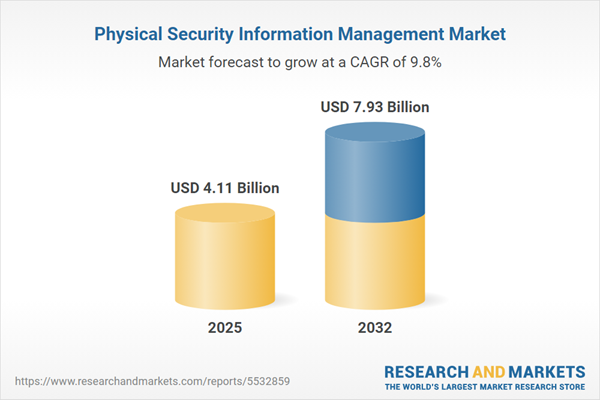Speak directly to the analyst to clarify any post sales queries you may have.
The Physical Security Information Management Market is undergoing rapid transformation as organizations seek to unify and enhance protection for people, assets, and data amid rising security complexities. Leveraging advanced integration and robust analytics, senior decision-makers now recognize centralized security management as vital for operational resilience and future-readiness.
Market Snapshot: Physical Security Information Management Market Growth Drivers
The Physical Security Information Management Market grew from USD 3.76 billion in 2024 to USD 4.11 billion in 2025. It is expected to continue growing at a CAGR of 9.77%, reaching USD 7.93 billion by 2032. This upward trajectory reflects the increased demand for integrated platforms capable of delivering actionable insights, meeting regulatory commitments, and ensuring responsive threat mitigation in diverse environments.
Scope & Segmentation
- Component: Services (consulting, implementation, maintenance & support, training), Software, Hardware (cameras, sensors, networking equipment, servers, storage units).
- System Type: Access control integration, building management integration, fire alarm integration, intrusion detection integration, video surveillance integration.
- Deployment Mode: Cloud-based, on-premises.
- Organization Size: Large enterprises, small & medium enterprises.
- End User: Commercial (banking & financial institutions, office complexes, retail chains & malls), government, industrial (energy & utilities, manufacturing facilities, transportation & logistics).
- Region: Americas (North America: United States, Canada, Mexico; Latin America: Brazil, Argentina, Chile, Colombia, Peru), Europe, Middle East & Africa (Europe: United Kingdom, Germany, France, Russia, Italy, Spain, Netherlands, Sweden, Poland, Switzerland; Middle East: United Arab Emirates, Saudi Arabia, Qatar, Turkey, Israel; Africa: South Africa, Nigeria, Egypt, Kenya), Asia-Pacific (China, India, Japan, Australia, South Korea, Indonesia, Thailand, Malaysia, Singapore, Taiwan).
- Key Companies: AARMTech Engineering Pvt. Ltd., Axxonsoft, BOLD Group, Brivo Inc., Champion Group of Companies, Condortech Services Inc., Genetec Inc., Hangzhou Hikvision Digital Technology Co., Ltd., Intel Corporation, Isarsoft GmbH, Johnson Controls International PLC, Mactwin Security, NEC Corporation, Nedap N.V., NICE Systems Ltd., Octopus Systems Ltd., Reliable Fire & Security, SAS Systems Engineering, Senstar Corporation, Siemens AG, TATA Consultancy Services Limited, TeleGroup d.o.o, Utimaco Management Services GmbH, Western Advance Group, Persistent Sentinel LLC.
- Technologies: Video analytics, artificial intelligence, machine learning, IoT integration, cloud and edge computing, open APIs.
Key Takeaways for Senior Decision-Makers
- Unified security management platforms now align with both operational continuity and data privacy demands, allowing organizations to consolidate alarm, access, and video systems for streamlined oversight.
- Adoption of open architectures and interoperability standards is rising, enabling third-party integration and supporting customizable workflows that keep pace with evolving threat landscapes.
- Advanced AI and machine learning are enhancing situational awareness and enabling predictive security responses, helping minimize risk and improve incident outcomes without heavy manual oversight.
- Vendors are differentiating offerings through embedded analytics, bundled services, and modular licensing models that address unique budget, compliance, and operational requirements across business sizes.
- Strategic partnerships with technology integrators and local supply networks are empowering end-users to scale capabilities efficiently and navigate regional regulatory and operational complexity.
Tariff Impact and Global Supply Chain Resilience
- Recent US tariffs on imported security hardware are prompting businesses to evaluate local sourcing, reevaluate total landed costs, and seek flexible procurement strategies for long-term agility.
- System integrators are adapting deployment and licensing models, including cost-spreading via bundled services, to maintain access to critical upgrades despite supply chain pressures.
- Vendors are diversifying manufacturing and assembly locations, supporting resilience and continuity across global operations as regulatory and economic conditions evolve.
Methodology & Data Sources
This study applies a mixed-method research approach, utilizing structured interviews with senior industry professionals and quantitative data analysis from multiple sub-segments. Extensive secondary research draws on regulatory publications, technical papers, and industry disclosures. All findings are cross-verified through triangulation for accuracy and relevance.
Why This Report Matters
- Provides in-depth, actionable insights to optimize physical security programs while balancing regulatory, operational, and cost considerations.
- Equips stakeholders with guidance on technology selection, system integration, and risk mitigation tailored to regional and industry-specific needs.
- Supports effective resource allocation and futureproofing strategies with comprehensive coverage of market drivers, challenges, and competitive moves.
Conclusion
This report delivers a roadmap for navigating the evolving landscape of physical security information management. Leaders gain the clarity to align security investments with organizational strategy and operational excellence.
Additional Product Information:
- Purchase of this report includes 1 year online access with quarterly updates.
- This report can be updated on request. Please contact our Customer Experience team using the Ask a Question widget on our website.
Table of Contents
3. Executive Summary
4. Market Overview
7. Cumulative Impact of Artificial Intelligence 2025
Companies Mentioned
The companies profiled in this Physical Security Information Management market report include:- AARMTech Engineering Pvt. Ltd.
- Axxonsoft
- BOLD Group
- Brivo, Inc.
- Champion Group of Companies
- Condortech Services Inc.
- Genetec Inc.
- Hangzhou Hikvision Digital Technology Co., Ltd.
- Intel Corporation
- Isarsoft GmbH
- Johnson Controls International PLC
- Mactwin Security
- NEC Corporation
- Nedap N.V.
- NICE Systems Ltd.
- Octopus Systems Ltd.
- Reliable Fire & Security
- SAS Systems Engineering
- Senstar Corporation
- Siemens AG
- TATA Consultancy Services Limited
- TeleGroup d.o.o
- Utimaco Management Services GmbH
- Western Advance Group
- Persistent Sentinel LLC
Table Information
| Report Attribute | Details |
|---|---|
| No. of Pages | 186 |
| Published | November 2025 |
| Forecast Period | 2025 - 2032 |
| Estimated Market Value ( USD | $ 4.11 Billion |
| Forecasted Market Value ( USD | $ 7.93 Billion |
| Compound Annual Growth Rate | 9.7% |
| Regions Covered | Global |
| No. of Companies Mentioned | 26 |









